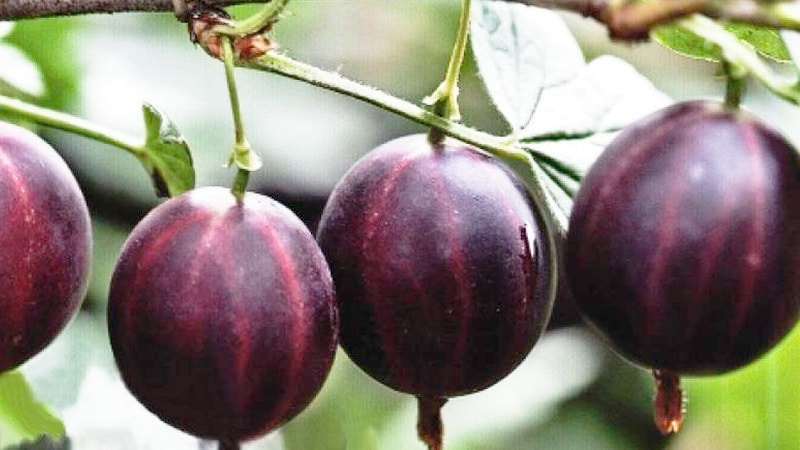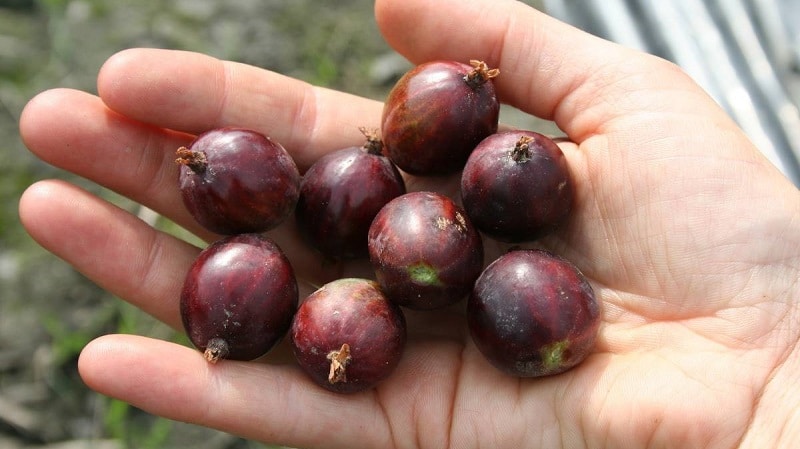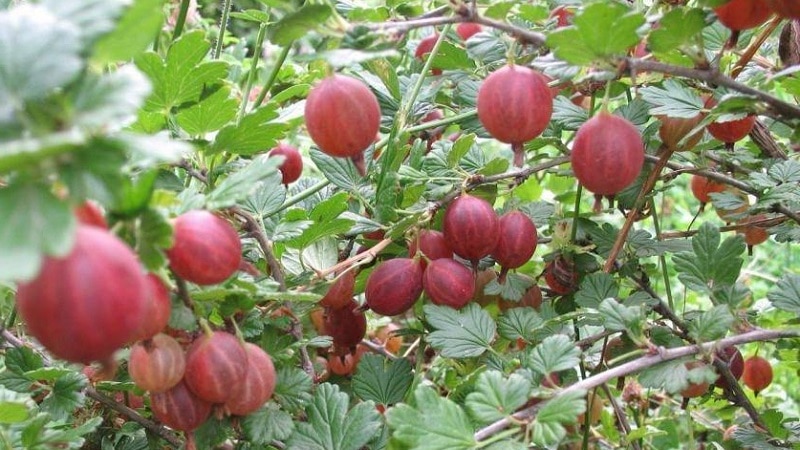An unpretentious thornless gooseberry variety Consul with excellent taste and strong immunity
Consul is a mid-season gooseberry variety, bred by a domestic breeder and won the love of gardeners for its characteristics. It forms large berries with a pleasant sour-sweet taste, bears fruit consistently for 20 years, and is resistant to frost and a number of diseases. We invite you to learn in detail about all the advantages and disadvantages of the variety and find out how to properly care for it in order to get a bountiful harvest.
What kind of gooseberry is this?
Consul is a thornless variety of medium-ripening gooseberry. The first berries appear on the bushes the very next season after planting, but the Consul begins to bear fruit fully after 2-3 years. The minimum yield is 10 t/ha, the maximum is 20 t/ha, 3-6 kg of berries are harvested from one bush.
Reference. The more berries on the bush, the smaller they are.
The fruits are ripening in mid-July, fruiting lasts approximately 5 weeks. The readiness of the crop for harvesting is judged by the color of the berries - they turn burgundy. At a temperature of +8...+15°C, gooseberries are stored for 1-3 weeks.
100 g of Consul berries contains 6.7% sugars, 3.1% (25.7 mg) ascorbic acid. Fruits help reduce cholesterol levels in the blood, have a calming effect on the digestive system, and prevent the development of anemia.

History of origin and distribution
Gooseberry Consul was bred in 1995 by breeder V.S.Ilyin at the South Ural Research Institute of Horticulture and Potato Growing as a result of crossing the Chelyabinsk green and African varieties.
The variety was included in the State Register of Breeding Achievements of Russia in 1995 under the name Senator with permission for cultivation in the Volga-Vyatka, Ural, West Siberian and Far Eastern regions.
Characteristics and description of bushes
Consul bushes are vigorous and medium spreading: the height reaches 1.5-1.8 m, the crown diameter is up to 2 m. The shoots are erect, slightly curved, pubescent, covered with green bark, which in the lower part may have a brownish-pink tint. There are few thorns, they are weak, single, growing perpendicular to the branches or downwards.
The leaves are medium-sized, green, with a wrinkled, slightly or medium-shiny surface. The leaf blades are straight, concave or convex, with a straight or rounded base, have a five-lobed shape and slightly wavy edges.
The petioles are thin and long, slightly pubescent, light green, located at an angle of 30° to the shoot. The buds are small, single, oval in shape. During flowering (third decade of May - early June), small flowers appear on the bushes, collected in inflorescences of 2-3 pieces. Sepals are narrow, not closed, reflexed. Pedicels are pubescent, green, long, thin.
Temperature resistance
This is a frost-resistant gooseberry variety - the bushes can withstand even a prolonged drop in air temperature down to -30°C. Flowers tolerate returning spring frosts even when grown in cold regions.
Moisture and drought resistance
Consul tolerates prolonged drought, but a prolonged lack of moisture negatively affects the quality and quantity of the harvest - there are fewer berries, they become smaller and more sour.
Excess water and waterlogging of the soil negatively affect the condition of plants. This provokes rotting of the roots and leads to the death of the bushes.
Resistance to diseases and pests
The variety is resistant to powdery mildew, practically not affected by septoria and sawflies. Dangers include anthracnose, American gooseberry mold, acacia and aphids.

Characteristics and description of fruits
Consul produces round berries that weigh 3-6 g and reach 2 cm in diameter. The fruits are covered with a thin fleecy skin of a dark red, almost black color.
The pulp is aromatic, almost transparent, marmalade-type, and has a dessert sweet and sour taste that is reminiscent of ripe grapes or kiwi.
Areas of use
One of the advantages of the Consul is its universal application. They are suitable for fresh consumption and processing: making preserves, confitures, jam, compote, marmalade.
Advantages and disadvantages of the variety
Advantages of gooseberry Consul:
- high and stable yield;
- pleasant taste of berries;
- frost resistance;
- thornlessness;
- immunity to a number of common diseases;
- long fruiting - up to 20 years;
- self-pollinating.
Among the disadvantages of the variety are poor transportability, a tendency to be affected by fungal diseases, and a decrease in the quantity and quality of the harvest as a result of prolonged drought.

Growing technology
To obtain a rich harvest of gooseberries of this variety, it is necessary to comply with standard agrotechnical requirements: choose the right place to plant the bushes, feed the plants and ensure that the soil does not dry out and is not waterlogged.
Optimal conditions
Consul is grown in a well-lit, sun-warmed area, protected from drafts and gusty winds. The soil should be loose, fertile, enriched with compost or manure, have good aeration and moisture permeability. The most suitable soil pH is 6.2–6.7.
Reference. To obtain green fertilizers, green manure is planted between the rows, and buckwheat is planted to prevent the appearance of soil pests.
Seedlings are purchased from specialized nurseries. Annual plants should have many small and dense roots without signs of disease, mold or mechanical damage. Specimens at the age of 2 years should have a smooth root collar and several shoots 10-15 cm long with buds.
A day before planting, the root system of seedlings is soaked in a solution of growth stimulants (Kornevina, Epina, Heteroauxin).
Landing dates and rules
Landing is carried out in the spring, immediately after the snow melts (late March - early April) or in the fall, about a month before the onset of frost (mid-October - early November).
Planting pattern:
- In the prepared area, dig planting holes 50-60 cm in size.
- Add a little peat or multi-component fertilizer to each hole for growing berry plants.
- Place a bush in the center of the hole and straighten its roots.
- Fill the voids with soil so that the root collar is buried 6-7 cm.
- Sprinkle the plantings with soil and compact it.
- Water the seedlings at the roots, mulch the tree trunk with sawdust.
Distance between bushes should be 1.2-1.5 m.
Further care
In case of no rain Consul's bushes are watered 2 times a month at the rate of 10 liters of water for each plant.After watering, the soil is loosened and weeded at the same time to improve aeration and moisture permeability.
Reference. If the soil is mulched or covered with agrofibre, weeding and loosening are not carried out.
Fertilizers are applied a year after planting the bushes according to the scheme:
- beginning of spring - nitrogen-containing fertilizers (12-15 g of nitrate per 10 liters of water) are applied in 2 stages with an interval of 10 days;
- before flowering - 70-80 g of potassium chloride and superphosphate or 0.3-0.4 kg of wood ash for each bush;
- after harvesting - 5 kg of manure or humus for each plant.
In cold and humid weather, foliar fertilizing with boron-containing fertilizers is carried out for better pollination of flowers and good berry set. If the soil pH is low, after the end of the growing season dolomite is added to the soil (300-500 g per hundred square meters).
In the first year after planting the Consul, in early spring, the stems are cut above the outward-facing bud 10 cm above the 1st, 2nd or 3rd eye. For 3 years, only the shoots of this year, crossing, diseased, damaged branches are pruned, then the oldest (4-year-old), damaged, diseased shoots are removed. Young shoots are shortened to half.

Possible problems, diseases and pests
Dangerous for culture illnesses and pests and methods of combating them are described in the table.
| Disease/pest | Signs | Prevention/treatment |
| Anthracnose | Small dark spots appear along the edges of the leaf blades; leaves fall from the bushes already in July. | After flowering, the bushes are sprayed twice with an interval of 10 days with Score 250 EC, Skower 250 EC, Kuprozan or Zato 50 WG fungicide. |
| American gooseberry mold | Before flowering, a light gray scaly coating forms on the leaves and green shoots; gradually it covers the berries, and the shoots dry out. | Before flowering, the bushes are treated with fungicides (Zato 50 WG, Nimrod 250 EC). |
| Acacia false scale | Pests eat shoots and leaves. | Shoots that are heavily attacked by pests are cut off, and the bushes are treated with Calypso 480 SC. |
| Aphid | The leaves are deformed, the bushes develop poorly, and the yield is significantly reduced. | The bushes are treated with onion or garlic broth, insecticides Pirimor 500 WG or Agro Pirymikarb 500 WG. |
Wintering
Consul is a frost-resistant gooseberry variety, so it does not require insulation. At the same time, in cold regions, the stems of annual bushes are bent to the ground, and the tree trunk circle is mulched with a thick layer of sawdust or straw.
Features of cultivation depending on the region
Regardless of the growing region, Consul has standard care requirements. Minor differences are only in the frequency of watering and winter shelter. Thus, in southern regions with a hot and dry climate, more frequent soil moistening is required, and in cold regions, gardeners use agrofibre or spruce branches to additionally cover the bushes for the winter.
Reproduction
Gooseberry Consul propagated in several ways.

Horizontal and vertical layers
At the end of autumn or winter, the mother plant is pruned so that the remaining strong shoots have 2-3 eyes located above the ground. This will stimulate the growth of young branches in the spring. When they reach 12-16 cm, they are covered with soil.
When rooting horizontally, the shoots are shortened by 1-3 cm and fixed horizontally above the ground, and the growing vertical shoots are additionally covered with soil to a height of 10 cm.
With vertical rooting, the mother bush is hilled up so that the soil partially covers the young shoots.After rooting, the branches are separated from the mother plant and planted in a permanent place.
Green cuttings
In autumn, shoots 25-35 cm long are cut from the bush, the woody part and the leaves below are removed. Then they are planted in the mother liquor at an angle of 45°, deepening to the middle, at a distance of 10-20 cm from each other. Next autumn, the rooted seedlings are transferred to a permanent place.
Pollinator varieties
Consul is a self-fertile gooseberry variety, which allows the crop to set without cross-pollination.
Reviews from summer residents
Gardeners leave positive reviews about the Consul gooseberry, noting its high yield, tasty and large berries, and low maintenance requirements.

Alexey, Kirov: “There are several Consul bushes growing at the dacha. I like the fact that it does not require pollinators, because the area is small and there is nowhere to plant them. At the same time, the yield is consistently high, the berries are large and very tasty. Over the years of cultivation, the bushes have never gotten sick, although several times I skipped preventative treatments, even though I know that this is not worth doing.”.
Marina, Orel: “The variety has a lot of advantages. I am pleased with the yield and taste of the berries, it is very convenient that there are no thorns on the branches, you can harvest without problems. The variety is unpretentious in care; you just need to prune it regularly and water it. I don’t cover it with anything additionally for the winter; the bushes tolerate cold well.”.
Vasily, Belovo: “I’ve heard so many reviews about the Consul, everyone praises its productivity. I'm not an exception. There are a lot of berries, they are tasty both fresh and after processing. There are no thorns on the bushes, the variety is resistant to disease and frost, and does not require pollinators to grow nearby. I can sincerely recommend Consul to those who choose a gooseberry variety for planting on their plot.".
Conclusion
Consul is a popular gooseberry variety of domestic selection, which is characterized by consistently high yields, excellent dessert taste of the fruit, resistance to low temperatures and many diseases, self-pollination and long-term fruiting. The disadvantages of the variety include poor transportability and susceptibility to fungal diseases.